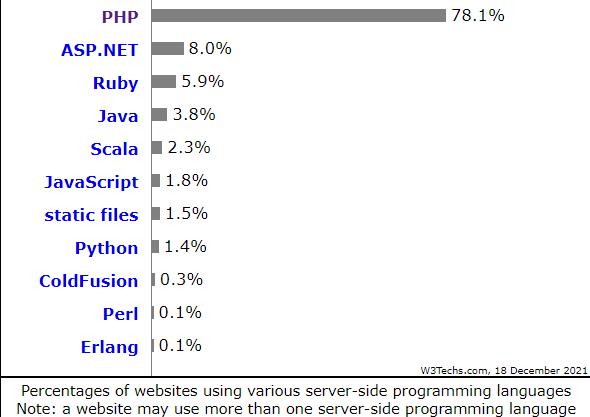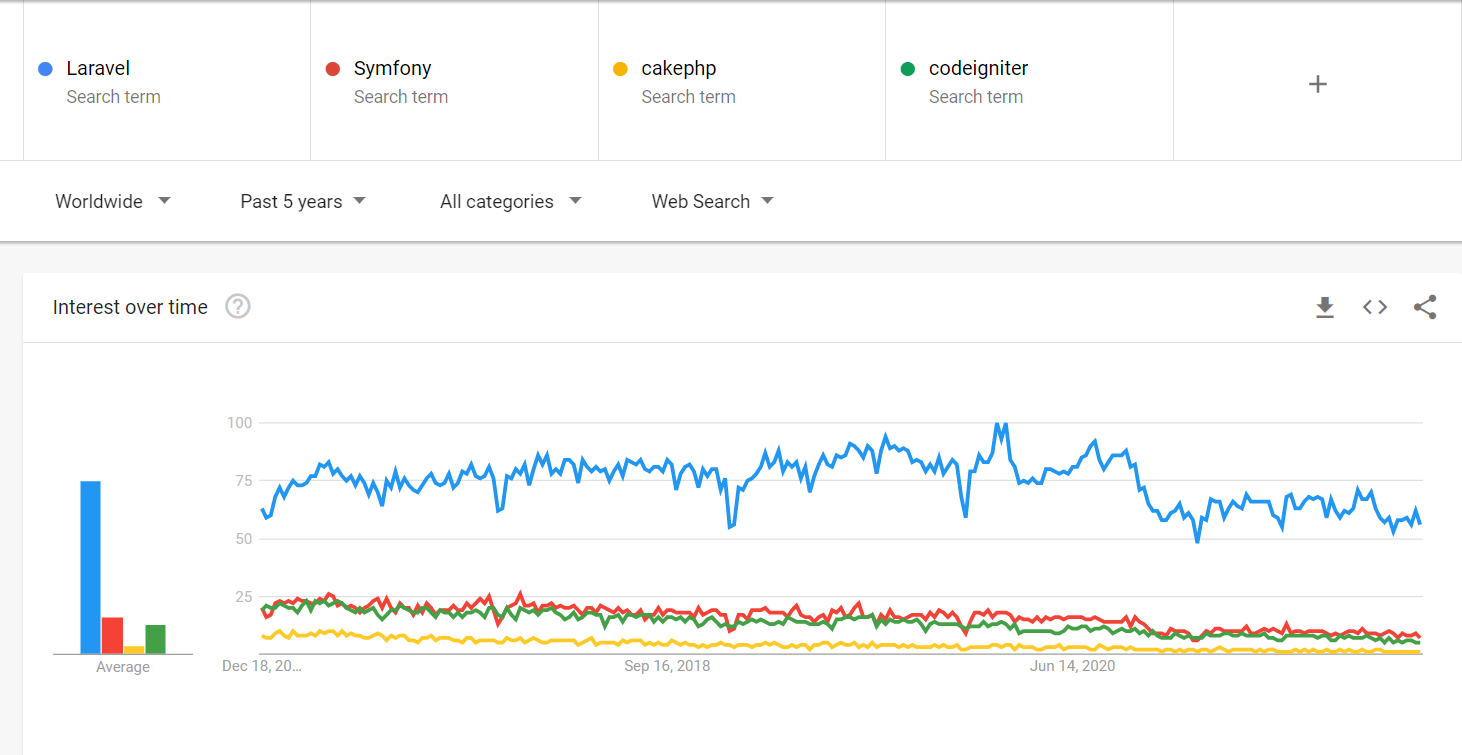Top 10 PHP Libraries for Web App Development:Facebook. Wikipedia. Xinhuanet.
These are some of the giants that use the PHP framework. Worldwide, 78.1% of websites use PHP as the programming language.

No wonder you too want to hire PHP developers. However, before you do, know about the top 5 PHP libraries to accelerate web app development.
In the next five minutes, you’ll learn:
- The basic features of the top 5 PHP libraries
- The pros and cons of each library
- Which PHP library should you choose
Note: The information is true at the time of writing. That’s December 2021.
Laravel tops the chart when it comes to the value of interest over time, as per Google Trends. That alone should tell you the popularity of the framework.

Source
You must have PHP 7.2.5 or higher to use Laravel. Alternatively, you can use Laravel Homestead. Furthermore, database support for MySQL 5.6+, SQL Server 2017+, or SQLite 3.8.8+ is needed too.
Laravel powers 645,082 websites worldwide.
Pros
- Laravel offers an in-built authentication system. Thus, you can focus on configuring the models, views, and controllers. The process speeds up web development.
- The in-built Artisan CLI allows developers to create database architecture and skeleton codes.
- Eloquent ORM (Object-relational Mapping) allows you to integrate database tables without the need to write SQL codes.
- The systematic database migration helps to extend the software database structure without modifying the same whenever there’s a change.
Cons
- Laravel doesn’t offer much in-built support. Thus, you must rely on third-party tools to resolve the issues.
- Laravel updates can cause minor problems.
- Laravel has a steep learning curve. Thus, you might have to spend hours learning the framework.
CodeIgniter has a total size of less than 1.2 MB. The PHP framework is best suited for developing dynamic websites.
You must have PHP 7.2 or higher to use CodeIgniter. Furthermore, database support for SQLite3, MySQL, or PostgreSQL is needed as well.
542,788 websites use CodeIgniter worldwide.
Pros
- The light footprint makes sure there’s no bloat. Thus, you can add the specific components you need.
- Offers protection against XSS and CSRF attacks. Furthermore, the framework includes a content security policy and context-sensitive escaping.
- While the framework encourages development with the MVC structure, it supports the coding of non-MVC apps too.
- Supports several caching methods. The process speeds up the web apps.
- The framework offers an easy learning curve.
Cons
- Doesn’t offer an in-built measured partition of the code. Thus, you must put extra time and effort to update and maintain the code.
- The offered libraries aren’t thorough. Thus, you’ll have to install third-party libraries to make the PHP framework fully functional.
- Lacks autoloader use and modern namespace. You must adhere to the standard approach for file and folder naming convention.
Sony Vaio UK site. Nobel Peace Prize. Food District.
These are some of the giants that use Symfony. The PHP framework is an excellent choice for web apps that must be scalable. The flexible modular component system allows developers to pick and choose components for a project.
You must have PHP 7.2.5 or higher to use Symfony. Furthermore, the system must have a composer installed as well.
Pros
- Supports all the popular databases such as MySQL, SAP Sybase SQL Anywhere, Oracle, and Drizzle.
- Offers data mappers to map objects to the database. The process separates the object model and the database schema. Thus, if you change a database column, you won’t have to change anything in your codebase.
- The Twig templating engine is fast, secure, and easy to learn.
- The in-built toolbar makes debugging projects easy.
- Offers a community of over 600,000 active developers. Thus, if you get stuck on an issue, you can find the answer right away.
Cons
- Comes with a large number of external dependencies. Furthermore, the custom modules rely on a strict architecture. Thus, you spend a lot of time testing which in turn, slows down the development process.
- Has a steep learning curve. Thus, if you have weak software architecture knowledge, you can get stuck using the framework.
- Performance often falters when a large audience is using a website or app at the same time.
Launched in 2006, Laminas Project now powers the websites of giants such as BBC and Cisco Webex.
The framework needs PHP 7.3 or higher and composer to function. Furthermore, database support for MySQL, Microsoft SQL Server, Informix Dynamic Server, or Oracle is needed.
Laminas Project is the continuation of the Zend PHP framework. The framework is often referred to as glue framework as well, thanks to its component-based nature. The framework has over 570 million installations worldwide.
Pros
- The MVC framework and the components follow enterprise development guidelines. Thus, the framework is best suited for complex web apps.
- The object-oriented nature allows developers to reuse codes.
- Developers can easily integrate the PHP framework with external libraries. The process extends the functionality of the framework.
- You can use the framework to build RESTful APIs.
- Offers a slack group and forum for support and collaboration.
Cons
- Comes with a steep learning curve. Thus, beginners and intermediate developers should steer clear of the framework.
- Offers plugins that are quite expensive.
- The over-documentation of the framework can sometimes confuse the developers.
Launched in December 2008, Yii is a perfect choice for making all kinds of web apps. Thus, the framework is known as a universal web application framework.
The system must have PHP 5.4.0 or higher to run the Yii framework. However, for best performance, we recommend having PHP 7+. Furthermore, database support for MySQL, SQLite, Oracle, MSSQL, or PostgreSQL is needed as well.
The component-based framework is simple to use.
Pros
- The well-written documentation allows developers to get the framework up and running within minutes.
- Offers multiple security measures such as authentication, encryption, authorization, and bcrypt password hashing. Furthermore, the documentation shares best practices to protect the framework against CSRF and XSS attacks and SQL injection.
- The Gii code generator builds skeleton codes for you with ease. Thus, you’ll save time you would’ve spent writing codes.
- Supports four caching types — HTTP caching, Page caching, data caching, and fragment caching.
- Allows developers to run third-party codes within Yii projects.
- Offers efficient error logging and handling systems.
- Theming and skinning mechanisms can switch the appearance of a website.
Cons
- The framework is dependent on static methods.
- Doesn’t offer building multiple relations or AR queries.
- The Ajax features aren’t well-written. Thus, developers need to take the help of JavaScript time and again.
Which PHP library should you choose?
With its features such as an in-built authentication system, Artisan CLI, Eloquent ORM and popularity, Laravel tops the chart of the PHP libraries for accelerating web app development. However, if you want a lightweight framework for building dynamic websites, go for CodeIgniter.
In this article, you have learnt:
- The basic features of the top 5 PHP libraries
- The pros and cons of each library
- Which PHP library should you choose
We hope the information will help you upscale your business.
Also read
Nailing the Email Marketing Design Strategically for your Audience
Trim Video Online Tool Makes It Easy to Trim Unwanted Parts from Videos
